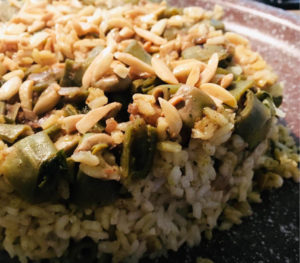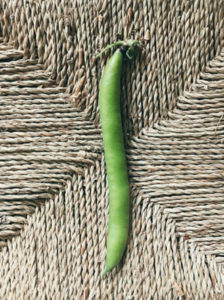By Mirna Bamieh
I cooked this recipe for the first time when I was conducting research for “The Edible Wild Plants Table,” celebrated by the Palestinian Museum in April 2019. It focused on wild edible plants and their traditional recipes in our Palestinian kitchen and paid particular attention to the plants that are almost forgotten yet safeguarded in the memories of our grandparents. Following several research trails, I identified the names, forms, locations, and availability of edible plants that grow in Palestine’s nature.
One of the recipes I enjoyed cooking and learning more about is green fava bean maqloubeh (lit. upside-down, a dish that fills its cook with pride when it keeps its form upon turning it out of the pot). Green fava beans are not wild, yet they are indispensable from our tables in the early spring when it is time for the baladi (lit. “my country”) heirloom fava beans that are full of intense flavors – to a greater extent than other types.
The beauty of this recipe is that whereas you can cook it in its vegetarian version, simply including chopped green beans and rice, you can alternatively also use meat broth or add a layer of meat (as the bottom layer). This dish would be called rabi’eh (referencing the spring season) in its strictly vegetarian form.
Ingredients:
Fava bean mixture
1 kilogram green fava beans, chopped into medium-size pieces
3 tablespoons olive oil
2 onions, finely chopped
4 garlic cloves, minced
1/2 cup chopped cilantro or parsley
1/2 teaspoon black pepper
1 teaspoon saltRice
3 cups rice
1 teaspoon dried cilantro
1 teaspoon mixed spices
1/4 teaspoon curcuma
1/2 teaspoon ground cinnamon
1/4 teaspoon black pepper
1 tablespoon salt (to taste)
A drizzle of olive oil
6 cups waterFried almonds or pine nuts for garnish
Method
1. Wash and soak the rice (for about 10 minutes).
2. Heat the olive oil in a medium-sized pot, add the finely chopped onions and minced garlic, cook.
3. Once the onions are translucent, add the green fava beans, salt, and black pepper, cook while stirring occasionally.
4. In the meantime, bring the water to a boil.
5. Strain the soaked rice and mix with the spices.
6. Once the vegetable mixture has cooked about 3-5 minutes, add the chopped cilantro or parsley.
7. Place the spiced rice on top of the fava bean mixture, do not stir.
8. Once the water starts to boil, add it to the pot (again do not stir, you want to keep the layers separated).
9. When the water starts to boil in the pot (again), add the salt and reduce the heat. Cover with a tight lid and cook for 20 minutes.
10. Turn off the heat and let the maqloubeh sit, without opening the lid, for 10 minutes.
11. Drizzle some olive oil on top and, with the back of a wooden spoon, poke some holes into the cooked mixture. Cover it again for another 10 minutes.
12. Now it is time to flip the maqloubeh. Don’t forget to bang the bottom of the pot for a minute or so before you remove it to let the maqloubeh separate.
13. Garnish with fried almonds or pine nuts.
Sahtein!
Mirna Bamieh is a chef, an artist, and the founder of Palestine Hosting Society. She runs culinary projects and hosts dinner performances all around the world on a mission to preserve traditional recipes and give them the attention they deserve in our kitchens and societies. For more recipes, please visit https://palestinehostingsociety.com



